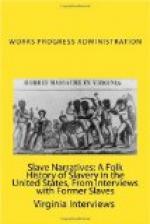Negroes who were unruly, or were caught attempting to escape, were usually sold to planters in the far south where they could not hope to escape, and were forced to end their days in unremitting toil in the cotton and cane fields, forever separated from relatives and friends.
It was the barbarism practiced by cruel masters, so vividly portrayed in such books as “Uncle Tom’s Cabin” and songs like “Nellie Gray,” that awakened the nation’s conscience and brought about the bloody “Civil War” which resulted in the race being set free.
Just before the war, George Davis, a mulatto, son of his master and a black servant girl, was in Cincinnati and was accosted by two white men who offered to use the good offices of the “Underground Railroad” to help him to get away to Canada. Being well treated, as a trusted servant of his white father and master, he did not avail himself of this opportunity to escape and stayed on as a slave until Freed by the war, after which he went to Ohio and settled and prospered until his death.
Another slave, Asberry Parker, did escape, and traveling by night hiding by day, reached safety in Canada where he worked and saved until he became wealthy. After the war, when he could safely return to the United States, he moved to Ironton, Ohio, where he made his home for the rest of his life. He belonged in his days of slavery, to a Williams family, in Carter County, Kentucky.
Another slave, George McVodie, belonging to the Poage family, of Boyd Co., escaped and went to Canada, no [TR: missing word?] as to whether he ever came back later.
A sister of George Davis was sold to a planter in Louisiana where she lived until 1877, when she returned to Boyd County as a free woman.
As negroes, in slavery days, were regarded as beasts of burden not much interest was taken in the welfare of their souls. Some kind hearted masters would allow them the privilege of meeting in religious service, where some one of their race in spite of the conditions of the times, could read and explain the Bible, would preach. Other masters would not allow this to be done. A negro would become, in character much like the family who owned him, i.e., an honest, moral and kindly master would have slaves of like qualities, while a cruel, dishonest master would usually affect his slaves so that they would be tricky and unreliable.
Where the master did not personally supervise his slaves and left them to the mercies of a hired “over-seer,” their lot was usually much worse, as these task-masters were almost always tyranical and were not restrained by a sense of ownership from abusing the helpless creatures under their authority as were the master’s, whose money was invested in them.
On one occasion, a young negro saw his own sister stripped naked and unmercifully whipped by one of these over-seers. He gathered up all of his small belongings and tied them in a bundle and securing a club of wood, laid in wait for the cruel ‘boss’ until dark, when he killed him with the club. He then escaped, via the “Underground Railroad.”




